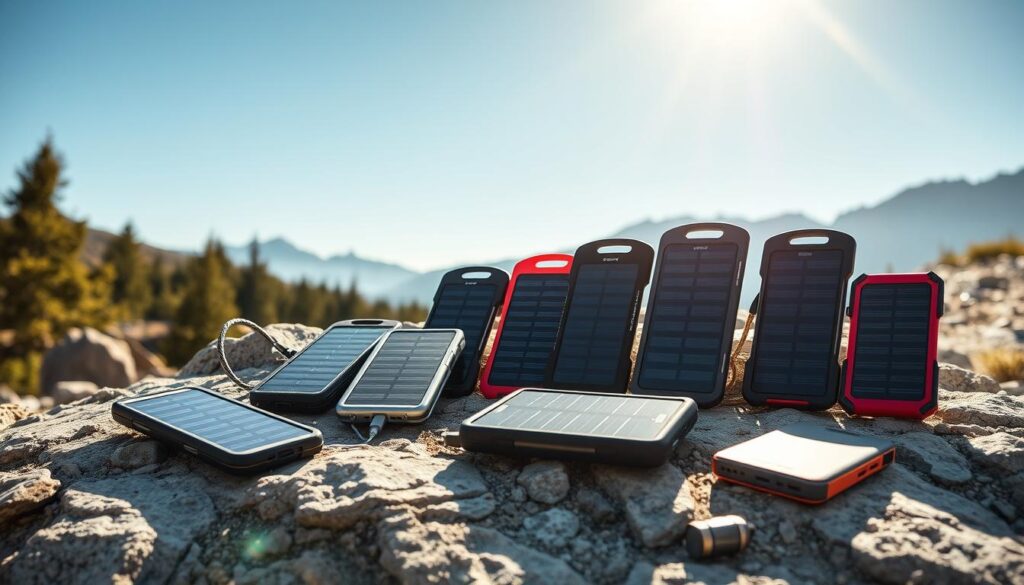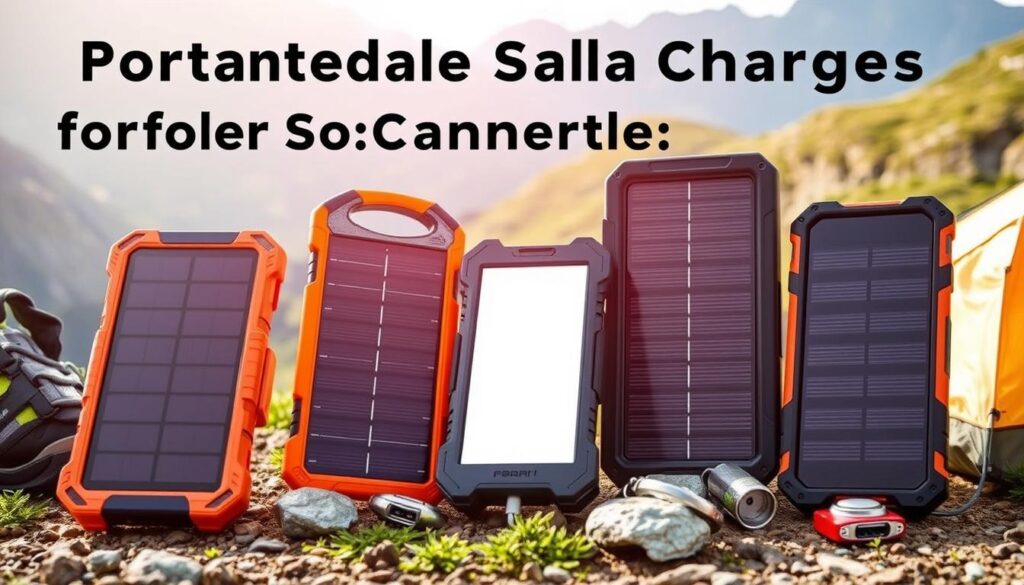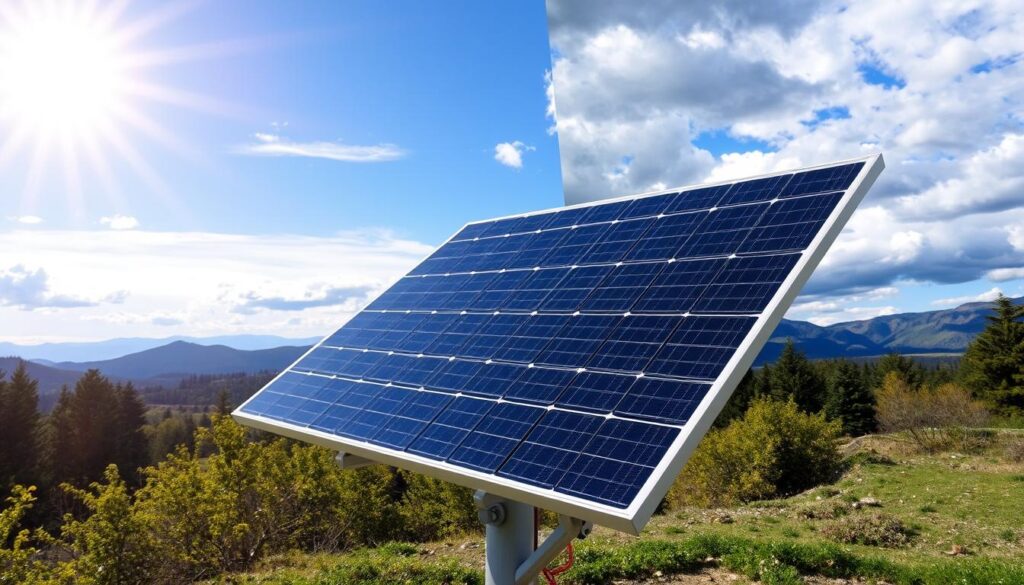Portable solar chargers are becoming more popular for outdoor lovers. They are perfect for hikers, campers, and adventure seekers. A good solar charger keeps your devices charged and connected outdoors. Let’s look at the top 5 portable solar chargers for outdoor use. They are durable, efficient, and easy to use.

Key Takeaways
- Portable solar chargers provide sustainable power for outdoor activities
- Top 5 options offer durability, efficiency, and ease of use
- Factors to consider include charging speed, capacity, and weather resistance
- Proper maintenance and storage can maximize solar charger lifespan
- Choosing the right solar charger enhances the outdoor experience
Understanding Solar Charger Technology for Outdoor Use
Portable solar chargers are a hit with outdoor lovers. They keep devices charged during adventures. These chargers use photovoltaic cells to turn sunlight into power.
How Solar Power Conversion Works
Photovoltaic cells in solar chargers catch sunlight. They use this energy to move electrons in the cells. This creates electrical current to charge devices like phones and tablets.
Key Features of Outdoor Solar Chargers
- Durable and weather-resistant construction to withstand outdoor conditions
- Foldable or compact design for easy portability
- Multiple USB ports for charging multiple devices simultaneously
- Built-in safety features to prevent overcharging and short-circuits
Power Output and Efficiency Ratings
When picking a solar charger, look at its power output and efficiency. The power output, in watts, shows how fast it charges and how many devices it can charge at once. Efficiency ratings tell you how well it turns sunlight into power.
| Feature | Importance |
|---|---|
| Power Output | Determines charging speed and number of devices that can be charged |
| Efficiency Ratings | Indicates how effectively the solar charger converts sunlight into electrical energy |
Knowing how solar chargers work and what to look for helps outdoor fans pick the right one. This ensures their devices stay powered up on their adventures.
Top 5 Portable Solar Chargers for Outdoor Adventures
Going on a hike, camping, or to the beach? A portable solar charger can change the game. These small, light devices use the sun’s power to keep your gear charged. We’ll look at the top 5 portable solar chargers for their performance, durability, and ease of use.
- Anker PowerPort Solar: This solar charger has dual USB ports and is compact. It’s efficient, making it a favorite for outdoor lovers.
- Blavor Solar Power Bank: It has a 10,000mAh battery and two USB ports. It’s great for long outdoor trips.
- Jackery SolarSaga 60W: Its high-efficiency panels and 60W output make it perfect for quick device charging.
- BEARTWO Solar Charger: Built for tough outdoor use, it’s waterproof and has a built-in LED flashlight.
- Goal Zero Nomad 7 Plus: This charger is small and light. It’s reliable and can charge many devices, including phones and tablets.
These top solar chargers offer unique features for outdoor fans. Whether you’re planning a camping trip or a hike, this list is a good place to start.
| Product | Solar Conversion Efficiency | Battery Capacity | USB Ports | Durability |
|---|---|---|---|---|
| Anker PowerPort Solar | 21% | N/A | 2 | Water-resistant |
| Blavor Solar Power Bank | 18-22% | 10,000mAh | 2 | Shockproof, dustproof, waterproof |
| Jackery SolarSaga 60W | 23% | N/A | 2 | Weather-resistant |
| BEARTWO Solar Charger | 21-23% | 10,000mAh | 2 | Rugged, waterproof, dustproof |
| Goal Zero Nomad 7 Plus | 18% | N/A | 1 | Water-resistant |
These solar chargers meet different outdoor needs. Whether you want high-efficiency chargers, durable camping gear, or lightweight hiking tech, this list is a good starting point.

“Having a reliable portable solar charger is essential for any outdoor adventure. These top-rated options ensure your devices stay powered up, no matter where your journey takes you.”
Essential Factors to Consider When Choosing a Solar Charger
When picking a rugged solar charger for outdoor fun, think about a few key things. These include how tough and weather-proof it is, how fast and much it can charge, and how easy it is to carry. These factors help make sure the charger fits your needs.
Durability and Weather Resistance
Outdoor activities can be rough on your gear. So, it’s important to choose a solar charger that can handle the weather. Look for ones with waterproof panels and a design that’s shock-resistant. This way, your charger will work well, even in bad weather.
Charging Speed and Capacity
The speed and amount your solar charger can charge are key. Check the power output in watts (W) and the battery capacity in milliamp-hours (mAh). Faster and bigger capacities are great for long outdoor trips when you need to keep your devices charged.
Portability and Weight Considerations
The size and weight of your solar charger matter a lot, especially if you’ll be carrying it around. Choose lightweight, compact chargers that are easy to carry. They should be tough and work well, making them a great addition to your outdoor gear.
| Feature | Importance | Ideal Specifications |
|---|---|---|
| Durability and Weather Resistance | High | Waterproof, shock-resistant design |
| Charging Speed and Capacity | High | High power output (>10W), large battery capacity (>10,000mAh) |
| Portability and Weight | High | Lightweight (under 1 lb), compact size |
By thinking about these important factors, you can find the best rugged solar charger for your outdoor adventures. It will keep your devices charged and you connected.
Maximizing Solar Charger Performance in Different Weather Conditions
As outdoor lovers, we know how key reliable solar chargers are for our devices on adventures. But, weather can affect how well they work. Here, we’ll share tips to get the most out of your solar charger in any weather, so you’re always connected and charged.
Cloudy Day Charging and Low Light Efficiency
While sunny days are best for solar charging, we can’t always count on clear skies. On cloudy days or in dim light, knowing how it affects your charger’s power is key. Cloudy day charging and low light efficiency matter a lot when planning your outdoor fun.
- Adjust panel positioning: Getting your solar panel to catch as much light as possible, even on cloudy days, boosts charging.
- Consider higher-capacity batteries: Choosing solar chargers with bigger batteries helps make up for less power on cloudy days.
- Explore hybrid charging options: Using solar charging with other power sources, like USB power banks, ensures your devices stay charged.
Temperature Effects on Solar Charger Performance
Temperature effects on your solar charger’s performance are important. Extreme heat or cold can hurt how well it works and how long it lasts.
- Maintain optimal operating temperatures: Use your solar charger in the right temperature range to avoid losing power.
- Provide shade or insulation: Keeping your solar panels out of direct sunlight or extreme cold helps them work better.
- Choose weather-resistant designs: Getting solar chargers with strong, weatherproof designs helps them handle temperature changes better.
Optimal Solar Panel Positioning and Charging Optimization
Solar panel positioning and charging optimization are key to getting the most from your solar charger. The right setup can really boost how fast and well your charger works.
| Positioning Technique | Benefits |
|---|---|
| Tilt adjustment | Aligning the solar panels to the sun’s position can increase energy capture and charging rates. |
| Tracking mechanisms | Automated or manual tracking systems keep the panels oriented towards the sun, enhancing performance. |
| Shading avoidance | Positioning the solar charger in an area free from obstructions and shadows maximizes energy generation. |
By using these tips, your solar charger will work its best, even in tough weather. A well-optimized solar charger means your devices stay charged and your adventures go smoothly.

Best Practices for Solar Charger Maintenance and Storage
Keeping your solar charger in good shape is key to its long life and performance. Simple steps can help you maintain your solar tech and fix common problems. This way, your charger will always be ready for your outdoor trips.
Cleaning and Care Guidelines
Cleaning your solar panel regularly is vital. Use a soft, lint-free cloth to remove dust and dirt. Don’t use harsh chemicals or rough materials, as they can harm the solar cells. Also, check the charging ports and connectors for any corrosion or blockages.
Storage Tips for Longevity
- Store your solar charger in a cool, dry spot, away from sunlight and extreme temperatures.
- Before long-term storage, charge it a bit to avoid battery drain.
- Use a soft, breathable cover to protect the solar panel from scratches.
Troubleshooting Common Issues
If your solar charger isn’t working right, try these fixes:
- Make sure nothing is blocking the solar panel’s sunlight.
- Check the charging ports and connections for dirt or corrosion.
- If the battery isn’t working, see the manufacturer’s guide for replacement or repair.
By following these maintenance and storage tips, your solar charger will stay reliable. It will keep your devices charged, even in the most distant places.
Conclusion
Portable solar chargers are a green way to power our outdoor fun. They make solar-powered hiking and eco-friendly camping possible. These devices use green technology to help us enjoy nature without harming it.
Choosing the right solar charger is key. Look for one that fits your needs, whether it’s durability, speed, or size. The top 5 chargers we talked about offer great options for sustainable outdoor adventures.
Let’s use the sun’s power for our next outdoor trip. A good solar charger will keep our devices charged. This choice helps our planet and encourages others to use renewable energy for outdoors too.
FAQ
What are the key features to look for in a portable solar charger for outdoor use?
When picking a portable solar charger for the outdoors, look for durability and weather resistance. Also, consider the charging speed, power output, and how easy it is to carry.
How do I determine the right power output and efficiency for my outdoor solar charger?
The power output and efficiency of a solar charger depend on your needs and the weather. Choose chargers with high-efficiency solar panels. They should have enough power to charge your devices quickly.
What are some tips for optimizing solar charger performance in different weather conditions?
To get the most out of your solar charger in various weather, position the panels for the best sunlight. Use features like charge controllers for cloudy days. Also, remember how temperature affects charging.
How do I properly maintain and store my portable solar charger for long-term use?
To keep your solar charger in good shape, clean the panels regularly. Store it in a cool, dry spot when not using it. Follow the manufacturer’s advice to make it last longer.
What are some of the top-rated portable solar chargers for outdoor adventures?
Top picks for outdoor solar chargers include the Anker PowerPort Solar and the Goal Zero Nomad 7 Plus. Also, consider the Biolite SolarPanel 5+, the Suaoki 20W Portable Solar Charger, and the Jackery SolarSaga 60W Portable Solar Panel.









